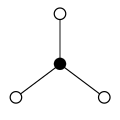Dihedral group
Dihedral Group[edit]
The Dihedral Group, denoted as Dn, is a mathematical concept that represents the symmetries of a regular polygon with n sides. It is a finite group that consists of rotations and reflections of the polygon.
Definition[edit]
The Dihedral Group Dn is defined as the group of symmetries of a regular polygon with n sides. It has 2n elements, which can be categorized into two types: rotations and reflections.
The rotations in Dn are denoted as rk, where k ranges from 0 to n-1. Each rotation represents a clockwise rotation of the polygon by an angle of 2πk/n. The composition of two rotations rk and rl is another rotation r(k+l) mod n.
The reflections in Dn are denoted as sk, where k ranges from 0 to n-1. Each reflection represents a reflection of the polygon along a line passing through a vertex and the midpoint of the opposite side. The composition of two reflections sk and sl is a rotation r(k+l) mod n if k+l is even, and a reflection s(k+l) mod n if k+l is odd.
Properties[edit]
The Dihedral Group Dn has several interesting properties:
1. Closure: The composition of any two elements in Dn is also an element of Dn. This property ensures that Dn is a group.
2. Identity Element: The identity element in Dn is the rotation r0, which represents no rotation.
3. Inverse Element: The inverse of a rotation rk is the rotation r(n-k), and the inverse of a reflection sk is itself.
4. Associativity: The composition of three elements in Dn is associative, meaning that (a * b) * c = a * (b * c) for any elements a, b, and c in Dn.
5. Non-Commutativity: In general, the composition of two elements in Dn is not commutative. That is, a * b is not always equal to b * a.
Examples[edit]
Let's consider the Dihedral Group D3, which represents the symmetries of an equilateral triangle. It has 6 elements: r0, r1, r2, s0, s1, and s2.
The composition of r1 and r2 is r3 (since 1+2=3 mod 3), which represents a full rotation of the triangle. The composition of r1 and s2 is s1 (since 1+2=1 mod 3), which represents a reflection along a line passing through a vertex and the midpoint of the opposite side.
Applications[edit]
The Dihedral Group Dn has various applications in different fields of mathematics and science. Some notable applications include:
1. Crystallography: Dihedral groups are used to describe the symmetries of crystals, which have a repeating pattern of atoms.
2. Robotics: Dihedral groups are used in robotics to represent the possible movements and configurations of robotic arms and manipulators.
3. Computer Graphics: Dihedral groups are used in computer graphics to generate symmetrical patterns and animations.
4. Group Theory: The study of Dihedral Groups provides insights into the general theory of groups and their properties.
See Also[edit]
References[edit]
1. Dummit, D. S., & Foote, R. M. (2004). Abstract Algebra (3rd ed.). John Wiley & Sons.
2. Rotman, J. J. (1995). An Introduction to the Theory of Groups (4th ed.). Springer.
-
Dihedral group
-
Dihedral group
-
Dihedral group
-
Dihedral group
-
Dihedral group
-
Dihedral group
-
Dihedral group
-
Dihedral group
-
Dihedral group
-
Dihedral group
-
Dihedral group
-
Dihedral group
Ad. Transform your life with W8MD's Budget GLP-1 injections from $75


W8MD offers a medical weight loss program to lose weight in Philadelphia. Our physician-supervised medical weight loss provides:
- Weight loss injections in NYC (generic and brand names):
- Zepbound / Mounjaro, Wegovy / Ozempic, Saxenda
- Most insurances accepted or discounted self-pay rates. We will obtain insurance prior authorizations if needed.
- Generic GLP1 weight loss injections from $75 for the starting dose.
- Also offer prescription weight loss medications including Phentermine, Qsymia, Diethylpropion, Contrave etc.
NYC weight loss doctor appointmentsNYC weight loss doctor appointments
Start your NYC weight loss journey today at our NYC medical weight loss and Philadelphia medical weight loss clinics.
- Call 718-946-5500 to lose weight in NYC or for medical weight loss in Philadelphia 215-676-2334.
- Tags:NYC medical weight loss, Philadelphia lose weight Zepbound NYC, Budget GLP1 weight loss injections, Wegovy Philadelphia, Wegovy NYC, Philadelphia medical weight loss, Brookly weight loss and Wegovy NYC
|
WikiMD's Wellness Encyclopedia |
| Let Food Be Thy Medicine Medicine Thy Food - Hippocrates |
Medical Disclaimer: WikiMD is not a substitute for professional medical advice. The information on WikiMD is provided as an information resource only, may be incorrect, outdated or misleading, and is not to be used or relied on for any diagnostic or treatment purposes. Please consult your health care provider before making any healthcare decisions or for guidance about a specific medical condition. WikiMD expressly disclaims responsibility, and shall have no liability, for any damages, loss, injury, or liability whatsoever suffered as a result of your reliance on the information contained in this site. By visiting this site you agree to the foregoing terms and conditions, which may from time to time be changed or supplemented by WikiMD. If you do not agree to the foregoing terms and conditions, you should not enter or use this site. See full disclaimer.
Credits:Most images are courtesy of Wikimedia commons, and templates, categories Wikipedia, licensed under CC BY SA or similar.
Translate this page: - East Asian
中文,
日本,
한국어,
South Asian
हिन्दी,
தமிழ்,
తెలుగు,
Urdu,
ಕನ್ನಡ,
Southeast Asian
Indonesian,
Vietnamese,
Thai,
မြန်မာဘာသာ,
বাংলা
European
español,
Deutsch,
français,
Greek,
português do Brasil,
polski,
română,
русский,
Nederlands,
norsk,
svenska,
suomi,
Italian
Middle Eastern & African
عربى,
Turkish,
Persian,
Hebrew,
Afrikaans,
isiZulu,
Kiswahili,
Other
Bulgarian,
Hungarian,
Czech,
Swedish,
മലയാളം,
मराठी,
ਪੰਜਾਬੀ,
ગુજરાતી,
Portuguese,
Ukrainian










